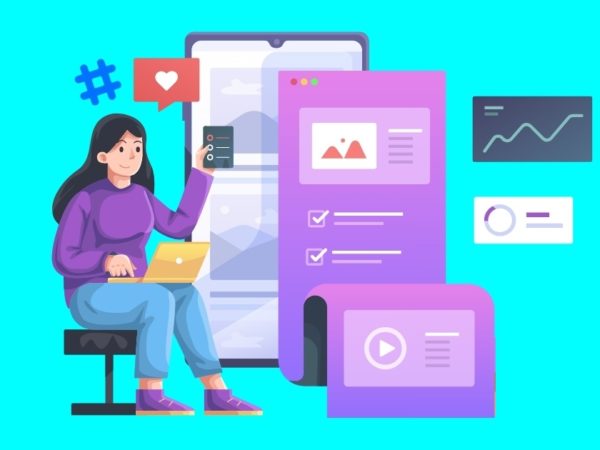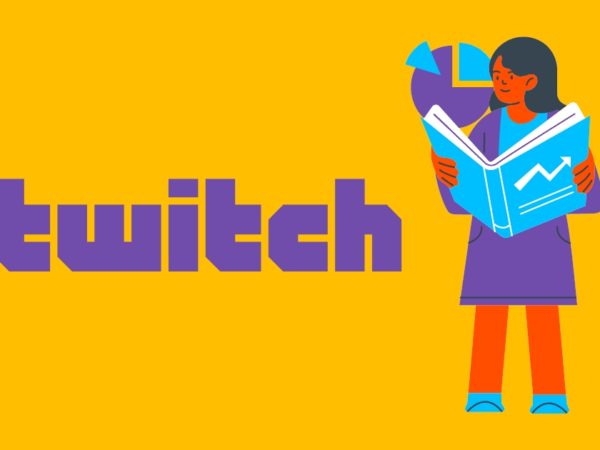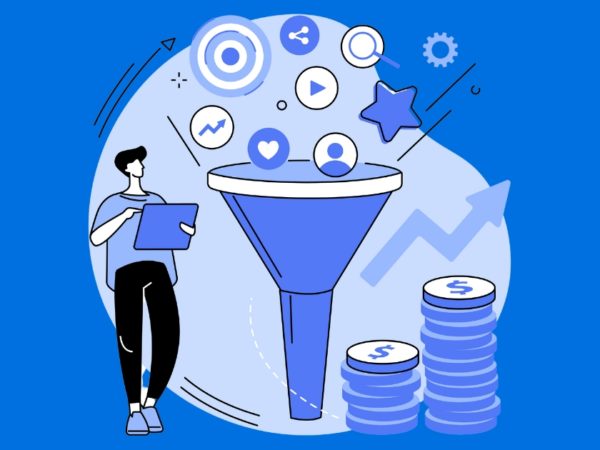All you need to know about inbound marketing tools and strategies.
The concept of inbound marketing emphasizes the value of creating content to attract visitors and guide them through the sales funnel.
It establishes customer relationships through relevant social network posts, email marketing, or mobile-friendly ads.
Inbound marketing breaks down traditional methods by talking to customers on the platforms they already use, delivering different messages on different platforms, and directing customers to make a purchase when they’re ready instead of pressuring them to make a purchase now.
After all, customers display more willingness to pay when they get the time to explore deals and believe they are getting the best bet. Thus, inbound marketing is a subtle way to turn leads into customers. Check out this handy table for a list of some awesome inbound marketing tools!
| Title | Description | Explore |
|---|---|---|
|
HubSpot |
All-in-one platform for marketing, sales, support. |
Explore |
|
Surfer |
SEO tool for first-page results, automated analysis. |
Explore |
|
SEMRush |
SEO tool for competitor analysis, keyword research. |
Explore |
|
Buffer |
Social media marketing with planning and analytics. |
Explore |
What is Inbound Marketing?
Inbound marketing is a strategic approach that focuses on creating valuable content for a business to attract customers. The digital marketing methodology is aligned with the organization’s long-term goal, which involves sharing information and crafting messages.
It is considered a problem-solving method for creating curiosity for the products, rather than pushing services to market. A prime is example is a good product landing page which is informative as well as sales orientated.
The idea behind an inbound marketing strategy is to attract potential customers to the brand, and the customers position themselves to receive the product after receiving valuable information.
Difference Between Inbound and Outbound Marketing
Here’s a table discussing the critical differences between inbound and outbound marketing:
| Description | Inbound | Outbound |
|---|---|---|
| Definition | Inbound marketing, also known as content marketing, attracts customers’ attention. | Outbound marketing is a traditional method of marketing to reach customers to sell services. |
| Focus | It focuses on creating informative content to attract customers’ interest. | It focuses on creating non-digital content to increase cutsomer’s focus on products. |
| Way of communication | Inbound marketing involves two-way communication where customers interact to get adequate product information. | It involves one-way communication where the marketer shares all the information about the products to sell them. |
| Technique | Its marketing technique is designed for potential customers. | Outbound marketing content is exposed to different types of audiences every day. |
| Method | This method is used to create brand awareness or visibility in the market. | In outbound marketing, the marketer introduces customers to specific products. |
| Approach | Brands seek customers’ permission before sharing information from inbound marketing. | The marketer interrupts customers to provide information about the product. |
| Goal | The goal of inbound marketing is to increase brand engagement in the market. | Its purpose is to create engagement with the product among the audience. |
How does Inbound Marketing Work?
CRM, ERP, and tracking cookies are used by inbound marketing to collect online behavior data. Marketers can use this information to connect with audiences interested in hearing from them on various platforms. Using data and strategy, brands can target customers already considering their goods or services through inbound marketing.
It can attract people interested in the business through content marketing, like by writing blog posts and articles about industry trends and other content targeted toward the target market based on customer segmentation.
Inbound marketing focuses on providing information to customers without pressuring them to make a purchase and forcing them to act before they are ready. The relationships that inbound marketing continues to foster and facilitate long after the first purchase is made are its greatest assets.
Types of Inbound Marketing
The following are four popular types of inbound marketing:
#1. Content Writing
Content wiring is the primary way to present brand information to customers. Brands create articles, blog writing, media posts, pre-product landing pages and more to reach audiences. Embracing inbound marketing with high-quality content can provide the ideal strategy to represent a business.
Through articles, brands can provide valuable information to their potential customers and make them aware of how the product or services will benefit them.
#2. Email Marketing
Email marketing allows brands to reach specific customers with their messages. It is a perfect way to promote the brand and stay connected with customers for long-term growth. Since the interested customer has provided their email address, brands can use it to build engagement with potential customers by offering promotions, content, reminders, and personalized messages.
Social media is increasingly becoming a medium for inbound marketing, allowing businesses to stay connected with their customers and make them aware of new services or products. It is a significant way to maintain brand exposure among potential audiences who regularly engage with the business by liking and sharing posts.
#4. Online Promotion
Online advertising is an effective way to reach potential customers, and brands are used to promote their services through paid advertising. The essential part of advertisements is that businesses use the pay-per-click model to increase their brand’s sales. What differs from traditional marketing is that the brand shares information about its services to generate customer interest.
How to Perform Inbound Marketing
Here are step-by-step processes for performing inbound marketing:
#1. Define the Buyer
Identifying buyers is the foundation of future marketing performance. Brands need to look at who they are representing, what they are interested in, and what their communication should be like to attract them. Communicating this way makes an impact on ideal customers.
Buyers have their particular interfaces, needs, and objectives. Understanding and capturing each buyer’s behavior will help focus summary creation on the points that attract the right customers for better targeted advertising.
#2. Set Inbound Marketing Goals
Specifying goals and the time frame within which the brands expect to see results is the first step in calculating the return on investment of their inbound marketing activity. The goals should be precise, measurable, attainable, relevant, and timely.
Before setting the inbound marketing objectives, evaluate the website’s ability to bring in visitors, convert leads, and close deals. Key performance indicators may include the following: Unique monthly website visits, number of monthly leads, SEO, blogging, social media, and email are all traffic sources.
#3. Outline Content Strategy
The process of attracting customers goes through three distinct stages:
- Top-of-funnel awareness refers to the initial stage of the customer journey, where they seek primary and general information about a specific topic. The main purpose of top-of-funnel content is to let more people know about the brand and convert those people into potential customers. Social media, blogs, videos, pictures, and presentations with information are all examples of content that many people can easily access.
- Mid-funnel evaluation refers to introducing potential customers to the brand and helping them understand what doing business with you is like. The content in the middle of the funnel begins to promote and introduce the product or service. Brands can use webinars, case studies, free samples, catalogs, FAQs, spec. sheets or brochures to introduce their brand and to give the audience something valuable.
- The bottom of the funnel is used by brands when the customer seeks information explaining how the product or service works and its benefits. People close to making a purchase are showing signs that they are considering the product/service. Sometimes, potential customers need to experience what you can provide. It could be a free trial, a demonstration of the product, a discount, or a free evaluation, consultation, or price estimate.
#4. Conversion Focus Marketing Strategy
Conversion-focused strategies are designed to attract large numbers of targeted visitors to the website to convert that traffic into qualified leads. By addressing buyer personas‘ frequent inquiries and motivating them to access the unique content, each marketing step supports a specific content proposition.
#5. Design the Lead Nurturing Process
There are many reasons customers fail to purchase a product; the need for more information is often the main reason hindering the sales process. If a lead has unresolved issues, they will likely need more time to get ready to move further down the marketing funnel. Automated email sequences are the most effective technique for contacting leads and responding to their inquiries.
Through email, automation leads are reminded or gently prompted that the brand has valuable content. It motivates potential customers to return to the content and move through the inbound funnel. Tactics like push notifications to help in converting leads to buyers.
#6. Hire an Inbound Marketing Team
Inbound marketing requires a comprehensive but focused skill set. Depending on the in-house experience, capacity for additional work, and budget size, it may be wise to hire for specific positions or outsource particular parts of the inbound marketing implementation.
Inbound Marketing Strategies
Here are some of the popular and effective strategies used by businesses for inbound marketing:
Create Great Content
Creating high-quality content should undoubtedly be one of the best inbound marketing strategies because we live in a world where content is king. Brands can accomplish this through their website and social media. Living in a content-first world, creating high-quality content should be one of the first inbound marketing strategies, which can be done on the website and social media.
Customers can learn more about the brand by watching or listening to podcasts, reading blog articles, or watching Internet videos that connect their interests to the products they offer.
For example, if the quality of current content is not up to marketing standards, audiences will not pay any attention to it. A brand must know where the target audience engages and what they are focusing on. If your business is highly effective on web page marketing and competitors are taking inspiration from social media, you must also focus on social media.
Optimize Research
The goal of an SEO strategy is to naturally direct customers to a business’s website, starting with the website’s primary landing pages. A brand’s page can rank better in searches on sites like Google, the top search engine, and Bing, the runner-up, if those pages are filled with keywords that potential buyers use to view the goods or services.
Beyond optimizing the site for keywords, we also need to ensure that the titles of all its landing pages are relevant to the target demographic and that the site is filled with metadata phrases matching them. More success in attracting potential customers to the website can be achieved by optimizing the content from an SEO perspective.
For example, the business can use SEO research tools like Google Search Console, Keyword Surfer, and SEMrush, which show current trending keywords and topics on Google web pages. Additionally, you can use this data to carry out inbound marketing activity by adding optimized keywords to the content.
According to BrightEdge, B2B companies generate twice the revenue from organic search than any other channel, where they get 76% of the search tariffs from the web.
Newsletters
Email newsletters are standard practice to engage with the target audience by emailing interested subscribers daily. By encouraging readers to click on content or links, these newsletters act as a marketing tool to attract readers to the company’s website.
Small business owners can also adopt the same strategy by building an email list and distributing newsletters to their dedicated subscribers from time to time. For example, send regular offers of products or services to existing customers because they share their email. You can create a special place in customers’ minds by giving regular updates about the business and future objectives. Zomato, a leading food delivery provider, uses newsletters effectively to promote business.
It starts the email with a one-liner on the subject and then includes related verbs in the body. Anyone who has connected with this company through email must have seen the funny and relatable phrases that Zomato uses to attract customers.
While social media can significantly impact consumer communications, traditional marketers strive to increase brand exposure there. Social media is valuable for small business owners without a dedicated advertising budget. Building a profile increases brand influence but requires spending money on social media advertising to improve the results.
For example, use social media platforms like Instagram, Facebook, or X (formerly Twitter) to connect with your customers. According to Statista, Facebook and Instagram are marketers’ most used social media platforms. A global survey shows that 89% use Facebook and 80% use Instagram to promote their business.
Benefits and Challenges
Benefits
Sustainability- Inbound marketing significantly impacts audiences, as information seekers will always have access to content, forms, and workflow/nurturing emails through various channels, especially websites. Multiple factors, including competitors and pricing, establish a brand’s positioning. It is also influenced by how customers interact with the brand and how they perceive it.
The core of inbound marketing is to offer content that solves or at least helps to solve a potential customer’s problem. Providing assistance and direction to a potential customer in this way reinforces the brand’s reputation as an authoritative, knowledgeable, and experienced entity.
Increased visibility- Making the brand, products, and services visible is often extremely important. Target consumers are constantly kept in touch with brands through their content creation and ongoing interaction through email and social media. Exposure as a supplier will be limited if the content is not published and marketed on channels the audience uses to find information, such as search engines. In the process, SEO value and resulting organic visitors increase, and the brand will also reach an entirely new audience.
Increased trust- As an organization, fostering a relationship and increasing trust with prospects by being available to help resolve common issues. Trust is the cornerstone of all business partnerships. People who visit websites organically, without any pressure from any brand, trust them more due to inbound marketing. Because inbound promotes two-way communication, it is beneficial in this regard as it makes it possible to establish a connection based on trust.
Challenges
- Requires skills- To execute inbound marketing successfully, a brand must be proficient in digital marketing, website building, blogging, social networking, content production and sourcing, SEO, and other relevant areas. They must either hire or train individuals to meet these criteria. Sometimes, outsourcing or automation is required to achieve the desired results.
- Effective utilization of tools- Investing in scalable resources and successfully implementing the inbound strategy can be difficult. With so many tools, marketers should investigate the options to choose the best technology for their campaign. Selecting the best software and tools and implementing them in a company setting can be difficult.
- Creative content- Content creation is the most challenging task in inbound marketing. Some areas that require frequent updating are original content creation, proper formatting, and constant release of fresh content. Delivery routes for content also need to be carefully considered and constructed with the target audience in mind. Recruitability sometimes requires additional resources. It may take some time to adjust to and implement a new plan.
HubSpot
American software developers and marketers HubSpot creates and markets products for inbound marketing, sales, and customer support.
<img alt="YouTube video" data-pin-nopin="true" data-src="https://kirelos.com/wp-content/uploads/2023/10/echo/maxresdefault.jpg653a60d21f296.jpg" height="720" nopin="nopin" src="data:image/svg xml,” width=”1280″>
It is a single platform for all things marketing. HubSpot Marketing Hub includes several key elements to enhance all marketing initiatives.
Key Features
- The CRM platform HubSpot is built to meet company scalability.
- The software includes all the capabilities needed for sales, marketing, customer service, operations, and content management.
- The primary features of this marketing tool include CRM integration, calls-to-action, marketing automation, lead management, website SEO, and more.
The foundation of its brand was inbound marketing, the best practice for small, medium, and large companies.
Surfer
Surfer is a top SEO tool promising to help businesses reach the first page of search engine results.
<img alt="YouTube video" data-pin-nopin="true" data-src="https://kirelos.com/wp-content/uploads/2023/10/echo/maxresdefault.jpg653a60d226c36.jpg" height="720" nopin="nopin" src="data:image/svg xml,” width=”1280″>
The primary process to get there is an automated content analysis to check the performance against competitors.
Key Features
- Surfer Content Editor provides real-time text scoring against competitors by suggesting content, keywords, and headlines.
- It gives a better understanding of the topics and keywords that search engines can rank the content using a keyword research tool.
- With the automated writing tool Surfer AI, you can quickly produce well-ranked articles.
Surfer also provides a real-time editor that shows relevant keywords as the brand writes content to improve it.
SEMRush
SEMRush is a popular SEO tool for competitor analysis, keyword research, and Google AdWords optimization.
<img alt="YouTube video" data-pin-nopin="true" data-src="https://kirelos.com/wp-content/uploads/2023/10/echo/maxresdefault.jpg653a60d233dbd.jpg" height="720" nopin="nopin" src="data:image/svg xml,” width=”1280″>
Digital marketers can use this all-in-one marketing reporting tool to optimize their websites for more organic search traffic.
Key Features
- This inbound marketing tool also helps you see the competitors’ data, like ad copy, keywords, traffic sources, etc.
- The software is also used in social media monitoring.
- It accurately identifies trends and patterns in a particular area. It will help you assess the on-page SEO and pinpoint areas that need improvement to generate leads more effectively.
Additionally, you can assess the competitive position and use the data to inform the decision-making when choosing keywords for Google Ads campaigns and organic search engine optimization.
Buffer
Buffer is a multifunctional software solution designed for social media marketing.
Key Features
- It allows social media content to be customized throughout the consumer experience with the help of publishing and scheduling techniques.
- The return on investment (ROI) of channel-specific and omnichannel activities is demonstrated through social media analytics and reporting.
- An integrated AI assistant facilitates idea generation, sentence rewriting, and publication date optimization.
The primary function of Buffer is the ability to plan and compose content for publishing on various social media platforms such as Facebook, Instagram, Twitter, LinkedIn, and Pinterest.
Final Words
Inbound marketing is a very strategic way to get potential leads for the business. The main goal of inbound marketing is to create exciting and valuable content.
Once a lead expresses interest in the company, you can communicate with them in various ways. You can increase their trust in the company by providing educational materials.
Thus, inbound marketing costs less.
The “right kind” of customers are encouraged to discover the organization by inbound marketing because they enjoy the content you are creating. Once leads reach you from inbound marketing, prepare them for the sale and keep them happy to retain customer loyalty.
Next up, learn how to collect Voice of Customer (VOC) to improve your business.



